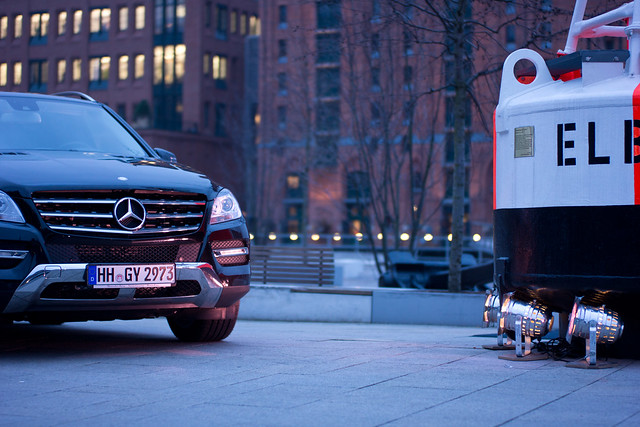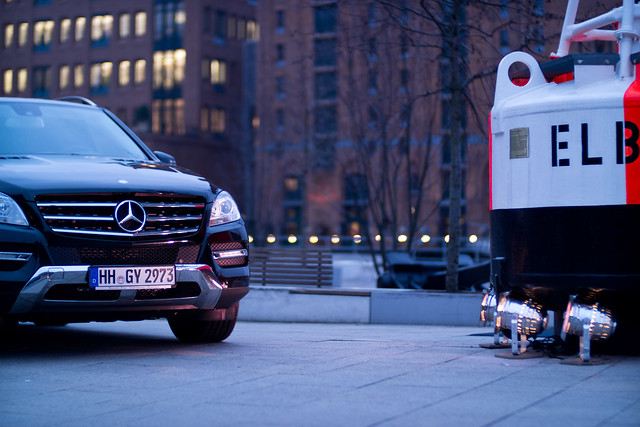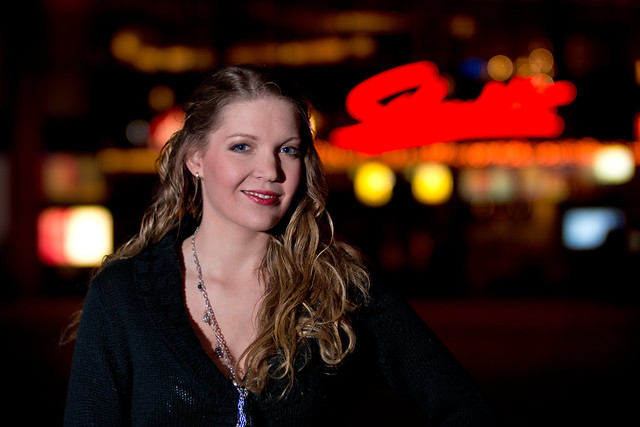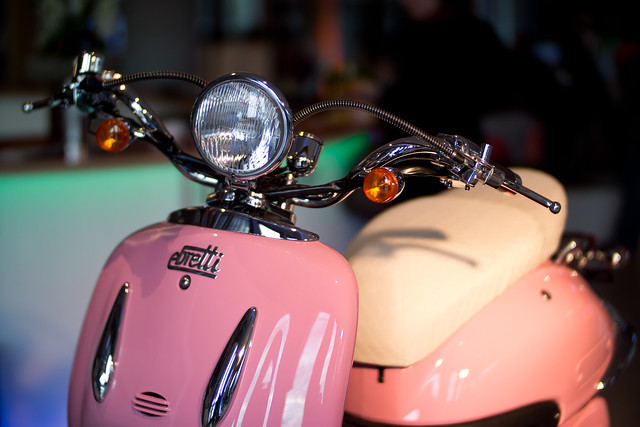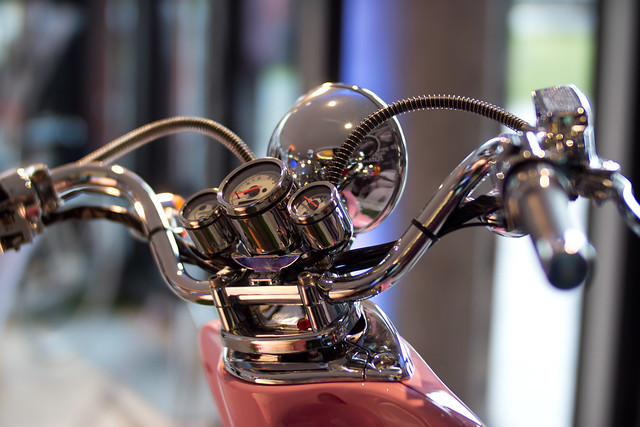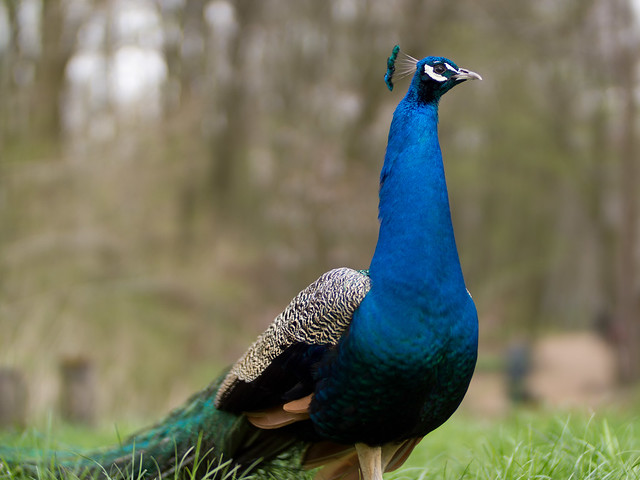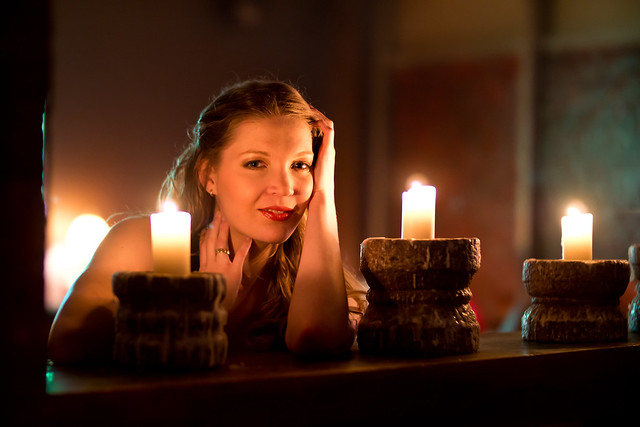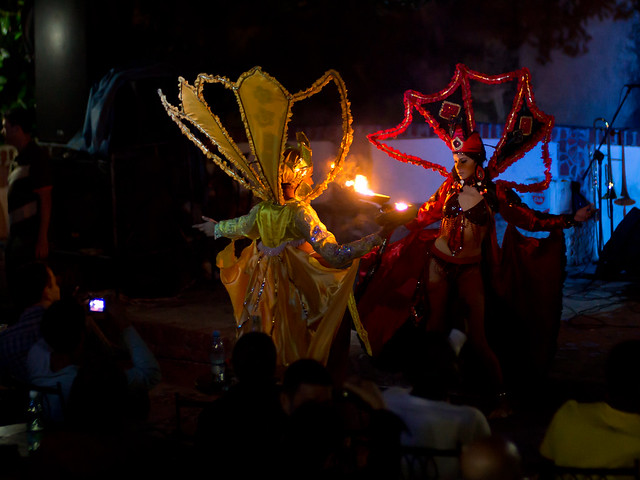If you are a bokeh enthusiastic and love shooting at low light (flash - what is that?), here is something that may make you even more addictive. SLR Magic is going to launch a new 50mm lens, the HyperPrime CINE T0.95 that will push the limit to a new level. This rolling review will keep you informed and will be continously updated with more images, videos, experiences and comparisons.
First let me state that I am not affiliated with SLR Magic, Leica or Sony, so you will see and read my pure personal impressions and opinions here. You may have heard already from SLR Magic's HyperPrime 50mm lenses and when first impressions of the CINE T0.95 were posted in the beginning of this year, I saw many people quite confused because they thought those reviews still adressed the 50m F0.95 lens that is already sold for some time under the NOKTOR label for MicroFourThirds and E-mount (Sony NEX). One of the reasons may have been that also the first prototypes of this new lens still carried the neon green ring, that Noktor lenses used to come with. But believe me: This new lens is a COMPLETELY different standard! The pre production sample that I received from SLR Magic already shows the final design (but carrying a "concept" mark) of the black ring version.

The new lens weighs about twice that much of the earlier model and
although it is designed as a professional cinema lens, there is
absolutely no doubt about it's qualities to be used for enthusiastic
photography as well. The aperture ring can be moved stepless and it is
calibrated in T-stops. It has no focus shift which
means the focus will not move when stopping down the lens. It has no breathing which means the focal length and so the angle
of view does not change when moving focus. The aperture blades close in a
very round circle so that bokeh still keeps those nice round circles of
confusion, when stopping down the lens - lights do not mutate to "stop signs"! The near distance is 0.7 meters (competitors like the Leica Noctilux usually start at 1m) which gives you some extra potential for creative usage of DOF.
So what means T0.95? As mentioned before, the aperture is calibrated in T-stops which is important for film makers that must make sure that the light transmission keeps the same when changing lenses at the same T-stop whereas F-stops only describe the calculated ratio of focal length and how wide the lens can open. Due to vignetting and other properties of the lens design, an F-stop of 0.95 typically results in a T-stop of 1.1 or so. Optically the lens is designed to have an F-stop of 0.92 at open aperture which makes it the fastest camera lens currently available for M-mount. This is possible due to an extremely large rear lens element:
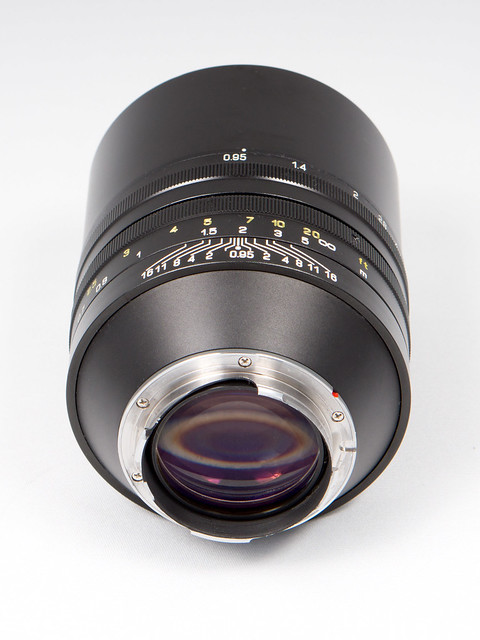
Beside the "CINE" version, SLR Magic offers also a "LM" version of this lens with a mechanical range finder coupling to be used e.g. on the Leica M9. The optical design is the same as for the "CINE" version but mechanically it contains different parts and materials but the largest amount of the prices difference goes into labour as it takes a lot of time to calibrate the range finder coupling.
Build quality
The lens has an absolutely exceptional build quality. It is solid like a tank (which you will feel, when carrying that lens around...). The operation of the (stepless) aperture ring and the focus throw feels like you expect it from such a lens. It is not a mass production lens so you can be sure that every single item is calibrated for optimal sharpness.
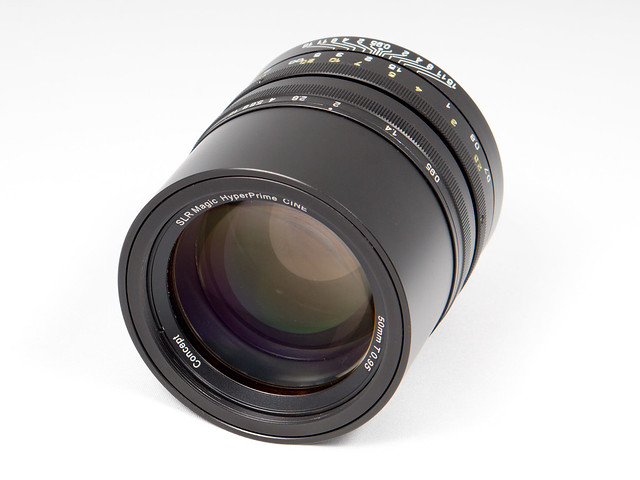
The lens comes with an extractable lens hood shown here:

Don't expect easy and quick handling from this lens. The depth of field (DOF) at open aperture is narrow to such an extent that you will need some time to precisely focus it. Focus peaking like in the newer NEX cameras may help you already a lot but under low light conditions you usually will have to go into 5x or 11x magnification in order to be precise enough. My recommendation is to use it on a (mirrorless) CSC camera equipped with an electronic viewfinder (EVF) like the Sony NEX-7:

To give you an idea of the size of this lens, let's compare it with some other "adorable fifties", the Leica Summilux-M 50mm F/1.4 ASPH and the new Sony E 1.8 / 50mm OSS (SEL 50F18):

A size comparison from top:

(from left to right: Leica Noctilux 50mm F/0.95 ASPH, SLR Magic HyperPrime CINE 50mm T0.95, Leica Summilux 50mm F/1.4 ASPH)
Sharpness and Bokeh
After all these boring product photos I will no longer keep you in suspense. Some small talk about sharpness and bokeh may be nice but pictures speak louder than words. Let's start with a short comparison at fair light conditions (focus was set to the star at the radiator grill of the car):
Sony E 1.8 / 50mm OSS (SEL 50F18) at F1.8:
Leica Summilux-M 50mm F/1.4 ASPH at F1.4:
SLR Magic HyperPrime CINE 50mm T0.95 at T0.95 (F0.92, 1/80s shutter, handheld):
Please do not take this image already as the final determination regarding sharpness at open aperture - it may still contain some motion blur.
Regardings sharpness, please consider this ISO 100 shots taken from tripod attached to the Lumix GH2:
SLR Magic HyperPrime CINE @ T0.95 (F0.92) ath the Lumix GH2:
Another bokeh comparison already at low light conditions:
SLR Magic HyperPrime CINE 50mm T0.95 at T1.4 with some minor fill-in flash:
SLR Magic HyperPrime CINE 50mm T0.95 at T0.95 (F0.92 with some minor fill-in flash and pushed by 1 stop due to under-exposure):
Bokeh at T0.95:
Bokeh at T1.4:
(Click for other sizes)
Focus on "Muck & Meck". Notable is that the circles of confusion can be kept nicely round even stopped down two by F-stops. The little spot you see close to the center of the circles of confusion when peeping the pixels is an issue with my particular sample.
For further sharpness and bokeh comparison, please see also the direct comparison to the Leica Noctilux.
Handheld shooting under extreme low light conditions:
This is a lens you typically take along hoping that it allows you to leave the tripod at home - and so did I when going into that shooting as I was asked by the bar staff to shoot without attracting attention. In order to see how far the limit can be pushed with that lens / camera combination under these conditions, the so enchanting and patient model Anja, her husband and I went to the "EAST" Hotel (thanks for their friendly property release). In their Yakshi's bar we had the chance to testdrive that lens (and of course some drinks) at nearly candle light conditions.
T0.95, ISO 1600, 1/10s handheld (only candle and smartphone display used to lighten the face)

(Click for other sizes but take into account that a picture shot handheld at 1/10s with ISO 1600 has motion blur and can not be used as reference for sharpness of this lens. It is just a demonstration which situations you can handle with this lens with APS-C 24 MP sensor cameras whose ISO performance is limited to 1600 when you are still expecting results with tolerable noise).
T0.95, ISO 1600, handheld at 1/10s shutter:
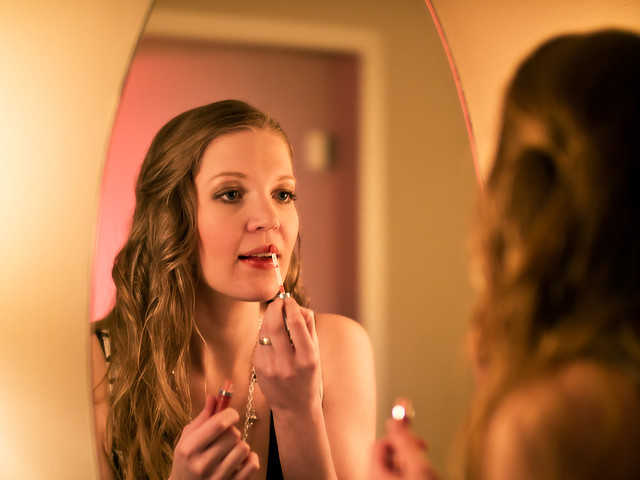
(Click for other sizes but take into account that a picture shot
handheld at 1/10s with ISO 1600 has motion blur and can not be used as
reference for sharpness of this lens. It is just a demonstration which
situations you can handle with this lens with APS-C 24 MP sensor cameras whose
ISO performance is limited to 1600 when you are still expecting results
with tolerable noise).
T0.95, ISO 1600, 1/30s shutter, handheld:
Freezing fast moving objects at extreme low light (T0.95, ISO 1600, 1/125s)
Another cool application is taking panoramas at extreme low light conditions:
This panorama was taken during an orchestra performance in a church with very little light with the panorama function of the Sony NEX-7. It covers a viewing angle comparable to a 16mm ultra wide angle lens. The camera takes 32 medium resolution photos with 1/500s shutter time in a short sequence and assembles them automatically to a panorama afterwards. At this low light even with T0.95 (F0.92) the camera went to its ISO 1600 limit and the image still had to be pushed by one additional stop afterwards. The original image is 8192 pixels wide, here (when clicked) you see a version scaled down to 4096 pixels. Not a perfect replacement for a fast ultra wide angle prime but still making things possible that I could not imagine so far.
Please see also the direct comparison to the Leica Noctilux.
There is more to come soon, e.g.
- precise sharpness test at ISO 100 from tripod
- some video work
So I will be happy to see you back here soon!
You can already preorder that lens at SLR Magic's home page where you also can see the prices.
Workshop
I am planning an "Adorable Fifties" workshop in Hamburg in July 29th 2012
during the celebration of the birthday of Hamburg's harbour. We will
have daylight and available light comparison shootings wit models in
nice locations. If you are interested in participating and can
contribute some adorable 50mm lenses as well, please mail to
info(at)3d-kraft.com.
UPDATE:
At the moment there is some bashing on SLR Magic regarding issues with the LM version (the version with rangefinder coupling) of that lens, which is mechanically more complex. I think this must be seen differentiated from the CINE version from which I saw no negetaive user reports so far. This is, what I wrote regarding that discussion in the "L Camera Forum":
"As far as I read this here [in the L-camera-forum], there were two or may be three people that had a problem with their LM (rangefinder coupled) version and their lens was either replaced or they got a refund. Most of the others complaining here just seemed to join in for bashing but never had this lens and propably also no Noctilux in their hands so far.
In my case, I got a prototype of the "CINE" version in February. It is the version without rangefinder coupling and so it is less mechanical complex and needs calibration only for the "infinite" focus position. Optically it is identical to the LM version. I took that lens on several trips, e.g. a three week roundtrip through Cuba in march, where it hat a hard time. It did not break apart or change its mechanical condition. You can see reviews and comparisons (also to the Noctilux 50/0.95 and the Summilux 50/1.4 ASPH) here, here and here and there will be another comparision workshop on July 29th with another Noctilux 50/0.95, a Nokton 50/1.1, a Canon 50/1.2 LTM and others.
My prototype (one of the first six samples built for volunteering reviewers) had some minor mechanical issues: The aperture ring was a bit too loose, the focus ring quite tight (but not tighter than on the Noctilux 50/0.95 I had for a first comparison) and there were some particles enclosed in the lens. I informed SLR Magic about the issues that I determined and although I did not explicitely ask for, they offered a replacement in June. The new copy works perfect. SLR Magic stated that there were some mechanical optimizations after the prototype feedback (and may be of those first buyers). The aperture and focus rings operate exactly how you would expect it and it is clean inside. The optical performance is how you would expect it from such a specialised lens, that is optimized for open aperture shooting as well. It is not the best choice for edge-to-edge sharpness but you do not really expect this when shooting at F0.92 and center resolution is at least on par with the Noctilux 50/0.95.
On the NEX-7 there is a contrast issue under very particular conditions but this can be controlled by a mask as described in my reviews. It has far less problems with purple fringing compared to the Noctilux and vignettes less at open aperture. The bokeh is a little bit different to the Noctilux but I would not say worse - just different and way better than the Nokton 50/1.1 bokeh. You should also consider that this lens has some optimizations for filmmakers (e.g. the stepless aperture measured in T-stops) so it was not really intended as a "Noctilux killer". This only, what some people tried to assign to it.
So I see no reason for a warning - at least not for the "CINE" version and not for SLR Magic in general at all. The situation for the LM version may be different at the moment. I think the calibration process for a lens with such a shallow DOF is a very complex issue and I think it is a process that should only be applied to a system of camera and lens together. Perhaps SLR Magic needs some time here to optimize the results and you should give them the time instead of bashing and accusing them. But this is not an issue for people who use that exceptional lens on cameras with EVF like Fuji X Pro 1 or NEX-7 anyway."
All images copyright by 3D-Kraft.com.






